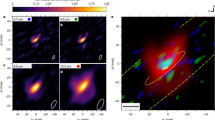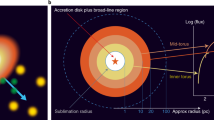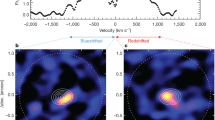Abstract
Active galactic nuclei (AGN) are generally accepted to be powered by the release of gravitational energy in a compact accretion disk surrounding a massive black hole1,2; such disks are also thought necessary to collimate the powerful radio jets seen in some AGN3. The unifying classification schemes for AGN further propose that differences in their appearance can be attributed to the opacity of the accreting material, which may obstruct our view of the central region of some systems. The popular model for the obscuring medium is a parsec-scale disk of dense molecular gas4, although evidence for such disks has been mostly indirect, as their angular size is much smaller than the resolution of conventional telescopes. Here we report direct images of a parsec-scale disk of ionized gas within the nucleus of NGC1068, the archetype of obscured AGN. The disk is viewed nearly edge-on, and individual clouds observed within the ionized disk are opaque to high-energy radiation, consistent with the unifying classification schemes. The projected axes of the disk and AGN are aligned, from which we infer that the ionized gas disk traces the outer regions of the long-sought inner accretion disk.
This is a preview of subscription content, access via your institution
Access options
Subscribe to this journal
Receive 51 print issues and online access
$199.00 per year
only $3.90 per issue
Buy this article
- Purchase on Springer Link
- Instant access to full article PDF
Prices may be subject to local taxes which are calculated during checkout


Similar content being viewed by others
References
Rees, M. J. Black hole models for active galactic nuclei. Annu. Rev. Astron. Astrophys. 22, 471–506 (1984).
2. Gunn, J. E. in Active Galactic Nuclei(eds Hazard, C. & Mitton, S.) 213–225 (Cambridge Univ. Press, (1979)).
Begelman, M. C., Blandford, R. D. & Rees, M. J. Theory of extragalactic radio sources. Rev. Mod. Phys. 56, 255–351 (1984).
Lawrence, A. Classification of active galaxies and the prospect of a unified phenomenology. Publ. Astron. Soc. Pacif. 99, 309–334 (1987).
Antonucci, R. R. J. & Miller, J. S. Spectropolarimetry and the nature of NGC 1068. Astrophys. J. 297, 621–532 (1985).
Krolik, J. H. & Begelman, M. C. Molecular tori in Seyfert galaxies—Feeding the monster and hiding it. Astrophys. J. 329, 702–711 (1988).
Pier, E. A. & Voit, G. M. Photoevaporation of dusty clouds near active galactic nuclei. Astrophys. J. 450, 628–637 (1995).
Gallimore, J. F., Baum, S. A. & O'Dea, C. P. The subarcsecond radio structure in NGC1068. II. Implications for the central engine and unifying schemes. Astrophys. J. 464, 198–211 (1996).
Muxlow, T. W. B., Pedlar, A., Holloway, A. J., Gallimore, J. F. & Antonucci, R. R. J. The compact radio nucleus of the Seyfert galaxy NGC1068. Mon. Not. R. Astron. Soc. 278, 854–860 (1996).
Gallimore, J. F., Baum, S. A., O'Dea, C. P., Brinks, E. & Pedlar, A. H2O and OH masers as probes of the obscuring torus in NGC1068. Astrophys. J. 462, 740–745 (1996).
Antonucci, R. R. J., Hurt, T. & Miller, J. S. HST ultraviolet spectropolarimetry of NGC1068. Astrophys. J. 430, 210–217 (1994).
Kellerman, K. I. & Owen, F. N. in Galactic and Extragalactic Radio Astronomy(eds Verschuur, G. L. & Kellermann, K. I.) 563–600 (Springer, New York, (1989)).
Capetti, A., Macchetto, F., Axon, D. J., Sparks, W. B. & Boksenberg, A. Hubble Space Telescope imaging polarimetry of the inner nuclear region of NGC 1068. Astrophys. J. 452, L87–L89 (1995).
Gallimore, J. F., Baum, S. A., O'Dea, C. P. & Pedlar, A. The subarcsecond radio structure in NGC 1068. I. Observations and results. Astrophys. J. 458, 136–148 (1996).
Mezger, P. G., Henderson, A. P. Galactic H II regions: I. Observations of their continuum radiation at the frequency 5 GHz. Astrophys. J. 147, 471–489 (1967).
Neufeld, D. A., Maloney, P. R. & Conger, S. Water maser emission from X-ray-heated circumnuclear gas in active galaxies. Astrophys. J. 436, L127–L130 (1994).
Krolik, J. H., McKee, C. F. & Tarter, C. B. Two-phase models for quasar emission line regions. Astrophys. J. 249, 422–442 (1981).
Krolik, J. H. & Begelman, M. C. An X-ray heated wind in NGC 1068. Astrophys. J. 308, L55–L58 (1986).
Pier, E. A., Antonucci, R., Hurt, T., Kriss, G. & Krolik, J. The intrinsic nuclear spectrum of NGC 1068. Astrophys. J. 428, 124–129 (1994).
Reynolds, C. F. & Fabian, A. C. Warm absorbers in active galactic nuclei. Mon. Not. R. Astron. Soc. 273, 1167–1176 (1995).
Begelman, M. C. & Fabian, A. C. Turbulent mixing layers in the interstellar and intracluster medium. Mon. Not. R. Astron. Soc. 244, 26P–29P (1991).
Mulchaey, J. S., Mushotzky, R. F. & Weaver, K. A. Hard X-ray tests of the unified model for an ultraviolet-detected sample of Seyfert 2 galaxies. Astrophys. J. 390, L69–L72 (1992).
Lawrence, A. The relative frequency of broad-lined and narrow-lined active galactic nuclei—Implications for unified schemes. Mon. Not. R. Astron. Soc. 252, 586–592 (1991).
Efstathiou, A., Hough, J. H. & Young, S. Amodel for the infrared continuum spectrum of NGC 1068. Mon. Not. R. Astron. Soc. 277, 1134–1144 (1995).
Sanders, D. B., Phinney, E. S., Neugebauer, G., Soifer, B. T. & Matthews, K. Continuum energy distribution of quasars—Shapes and origins. Astrophys. J. 357, 29–51 (1989).
Ferland, G. HAZY, a Brief Introduction to Cloudy(Internal Rep., Dept of Physics and Astronomy, Univ. Kentucky, Lexington, (1993)).
Ueno, S.et al. ASCA observations of NGC 1068. Publ. Astron. Soc. Jpn 46, L71–L75 (1994).
Cornwell, T. & Braun, R. in Synthesis Imaging in Radio Astronomy(eds Perley, R. A., Schwab, F. R. & Bridle, A. H.) 167–181 (ASP Conf. Ser., Astron. Soc. Pacif., San Francisco, (1994)).
Acknowledgements
The VLBA and VLA are operated by the National Radio Astronomy Observatory which is operated by Associated Universities, Inc., under cooperative agreement with the NSF. J.F.G. received support from a Collaborative Visitor's Grant from the Space Telescope Science Institute.
Author information
Authors and Affiliations
Corresponding author
Rights and permissions
About this article
Cite this article
Gallimore, J., Baum, S. & O'Dea, C. A direct image of the obscuring disk surrounding an active galactic nucleus. Nature 388, 852–854 (1997). https://doi.org/10.1038/42201
Received:
Accepted:
Issue Date:
DOI: https://doi.org/10.1038/42201
This article is cited by
-
Cool outflows in galaxies and their implications
The Astronomy and Astrophysics Review (2020)
-
Nuclear obscuration in active galactic nuclei
Nature Astronomy (2017)
-
Investigation of the obscuring circumnuclear torus in the active galaxy Mrk231
Nature (2003)
Comments
By submitting a comment you agree to abide by our Terms and Community Guidelines. If you find something abusive or that does not comply with our terms or guidelines please flag it as inappropriate.



